An inside look at accreditation of veterinary technology programs
The education of veterinary technicians and the education of veterinarians naturally share similarities, says Kelly Foltz, vice chair of the AVMA Committee on Veterinary Technician Education and Activities.
“I think you’re always starting with a person who has a passion for animals, and you’re trying to use STEM (science, technology, engineering, and math) education to shape that person into a medical practitioner,” she said. “I think there are steep learning curves in both professions, like handling animals and how to read body language and assess pain and know normal behaviors so you know when an animal is sick.”
Both members of the veterinary health care team rely on their education to perform their jobs to the best of their ability and maintain a level of trust with the public. That wouldn’t be possible, though, without accreditors such as the CVTEA for veterinary technology programs and the AVMA Council on Education for veterinary colleges, which go to great lengths to ensure programs produce practice-ready graduates.
Rigorous education
About 5,000 veterinary technology students graduated this year from the more than 200 programs accredited by the CVTEA. That’s according to soon-to-be-released data from the AVMA CVTEA–Accredited Veterinary Technology Program Mega Survey.
The CVTEA requires that each of those graduates are deemed competent in over 300 essential skills, from how to draw blood to anesthesia induction to applying crisis intervention and grief management skills with clients.
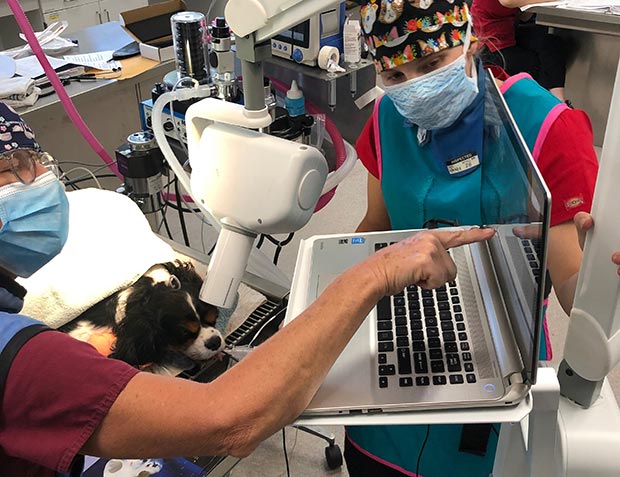
Tracy Blais, CVTEA chair, says it’s an intense experience to be a veterinary technology student as many take classes not only in anatomy, chemistry, and biology but also in English, math, and writing—often in only two years. They must take clinical nursing for small animals, laboratory animals, and large animals, learning radiology, anesthesia, surgery, hematology, and more. Plus, veterinary technology students must complete a practical experience in a clinical setting, which is frequently spread among multiple externships.
At the end, a majority of veterinary technology students will have taken the Veterinary Technician National Exam as well because most state and provincial agencies use the test to evaluate the competency of entry-level veterinary technicians and require a passing score to be credentialed.
How the CVTEA works
Nearly all states also require a person to be a graduate of a CVTEA-accredited veterinary technology program to be eligible for credentialing in the state. To earn CVTEA accreditation, veterinary technology programs must apply, complete a self-study report, and go through an accreditation site visit. Then the CVTEA makes an accreditation decision on the basis of that information. Accreditation cycles are every five years; however, programs must typically file annual or biennial progress reports.
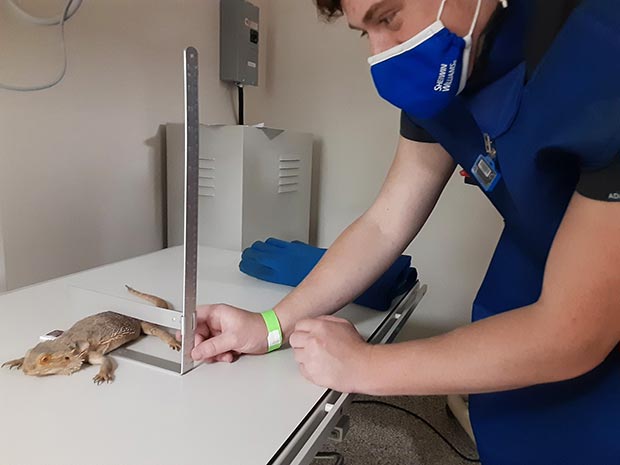
All 20 volunteer members of the CVTEA are assigned a certain number of programs, and each member chairs site visits—usually two or three a year—to the assigned schools. Other participants on the site visit are an AVMA staff member assigned to the CVTEA along with a veterinary technician, a veterinarian, and a member of the public, all three selected by the program. The CVTEA resumed in-person site visits and meetings this year after performing them virtually since early 2020 because of the pandemic.
The CVTEA meets twice a year. During the meetings, programs that have completed site visits—around 50 annually—are discussed and voted on. That means each committee member is expected to read all the information for each of the programs. This ensures that when the person who chaired a site visit discusses the school, everyone is knowledgeable, can ask questions, and can vote on an accreditation decision.
Blais, the committee chair, adds that AVMA staff members—Laura Lien, Rachel Valentine, Julie Horvath, and Dr. Paula Parker—are the heart and soul of the CVTEA.
“They are fantastic people to be with,” Blais said. “They know so much, and we cannot do our jobs without staff who know everything about all the programs. They don’t even need to look at the P&P (policies and procedures) anymore.”
Blais, who is the assistant program director for the University of Massachusetts-Amherst’s veterinary technology program, says it’s interesting to see how programs accomplish meeting the same standards differently yet still successfully.
“This is the place to be if you’re looking to help improve vet tech education in the future,” she said. “It’s an honor to be on the committee, and as much work as it is, it’s pretty amazing to be part of.”
Foltz, the CVTEA vice chair, is the mid-Atlantic regional nursing partner for BluePearl Emergency and Specialty Pet Hospital. She’s learned there is more than one right way to approach accreditation standards, and she has become more aware of challenges to the profession of veterinary technology on a larger scale.
“It’s easy as a veterinary technician to be isolated about concerns from your facility or state,” Foltz said. “This gives you an aerial view of the profession, education, and how different colleges and states and municipalities do things.”
She continued: “Our meetings are very galvanizing, inspiring, and energizing. It’s exciting to hear about (other members’) site visits and talk about how we can best serve our community of educators and students by updating or changing things or addressing concerns.”
Changes over the years
About 20 years ago, the CVTEA reevaluated its accreditation standards and asked programs to create standard criteria for all the essential skills that veterinary technology students must learn and provide documented proof that students were, in fact, learning all these required skills.
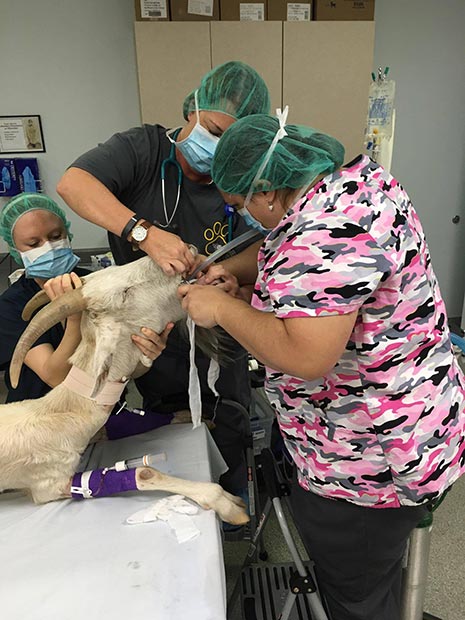
“In vet tech education, you can have so many faculty coming and going, so you have to ensure consistency from one to the next. The best way is standard criteria,” Blais said, which requires programs to sign off on 300 skills in which students have demonstrated competency.
“Luckily, now we have cloud-based programs where we can log student skills, so when the CVTEA comes, you can just show printouts,” making it easier for programs to demonstrate that students have learned each of these skills.
Blais said the CVTEA doesn’t back down from decisions regarding the accreditation process that it feels are important, even if they aren’t popular initially. The decisions come after listening to stakeholders and taking time to discuss and implement changes.
For example, the committee made changes to its Accreditation Policies and Procedures to require that every veterinary technology program publicly report data on the number of first-time candidates who have taken the VTNE and the three-year mean pass percentage. Programs were required to have the information posted by January 2014; however, the implementation was delayed until 2017 to provide programs time to comply. Since then, veterinary technology programs have been required to update their VTNE information by Sept. 1 each year on the institution’s website.
The CVTEA has also required that a program’s three-year mean rolling VTNE pass percentage for first-time test takers must be 50% or higher. Compliance was expected by Sept. 1, 2020, but that was delayed until Sept. 1, 2021, because of COVID-19. Programs not in compliance by that time may be subject to a change in accreditation status.
“That sounds very reasonable, but it was very controversial because it’s a three-year pass rate, so if you have some bad scores, it will take some time to get the (average) scores up,” Blais said.
An issue arises, too, in the states where veterinary technicians are either not credentialed or where credentialing is voluntary. In those cases, the VTNE is not considered a high-stakes test, which can lead to overall lower test scores in those states, Blais explained.
More recently, the CVTEA has spent several years discussing a new rabies standard. This past January, the policies and procedures were changed to require that students must either be vaccinated against rabies, or the program must implement a comprehensive rabies mitigation protocol.
Foltz said there was a lot of concern on the committee about student safety.
“There are parts (of the country) where rabies is endemic, and other programs use random-source animals or (animals) from animal control, where there’s not necessarily documented history,” Foltz explained. “We’re trying to work with programs on where they are and also protect students.”
Blais said the rabies vaccination requirement will provide needed protection to graduates and decrease liability to practices who employ them.
An issue the CVTEA is currently monitoring is apprenticeships. The Washington State Veterinary Board of Governors voted May 5 to support an apprenticeship program for veterinary technicians as an alternative pathway to licensure as a veterinary technician in the state.
The Washington State Apprenticeship Training Council will next determine whether to approve the official program, after which the veterinary state board will discuss further steps in the program being a pathway to licensure in Washington, according to the Washington State Association of Veterinary Technicians.
The AVMA, National Association of Veterinary Technicians in America, Washington State VMA, and WSAVT testified against the proposal at the May 5 meeting of the state veterinary board.
“Insisting on AVMA accreditation for all veterinary programs as a pathway to licensure is paramount in ensuring the growth and sustainability for the profession, as well as upholding safety for the public and their pets,” according to a statement from the WSAVT.
Education behind the job
Jennifer Serling, president of the Association of Veterinary Technician Educators, said veterinary technicians have been working toward a national credentialing standard so that everyone—regardless of the state—is being utilized in the same way and so that all credentialed technicians complete formal education and are not just trained on the job.
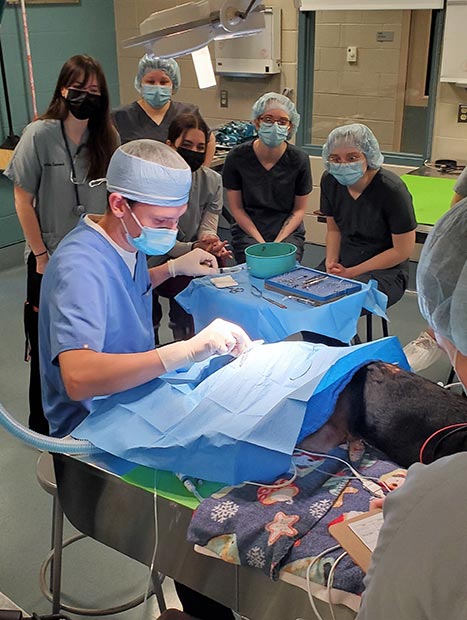
Protecting education behind the job is vitally important, she said, because those trained technicians understand the why behind what they’re doing.
For example, she said, if a dog has a bleeding disorder, a credentialed technician would know why to draw from one vein and not another because of the dog’s breed.
“Same thing with anesthesia,” Serling said. “I can tell someone if the heart rate does this, you turn the machine to this number. But understanding why an animal is reacting to the anesthesia the way they are is important.”
Serling continued: “You wouldn’t want your child used as practice for someone learning on the job. It should be the same way in veterinary medicine. You should expect technicians who are working with your pet to have the same educational background nurses do (in human medicine). We should have education behind this as well.”
Blais worked as a veterinary technician trained on the job during high school at her local veterinarian’s clinic, but she later went on to get her degree in veterinary technology from Mount Ida College, now UMass-Amherst, and become a credentialed veterinary technician.
She didn’t like the fact that she might not have been able to transfer what she learned on the job at one hospital to another hospital. That’s what she loved about graduating from a CVTEA-accredited program—she could take her skills anywhere.
“You are not trapped at that one practice where you learned your skills on the job,” Blais said. “Also, if I decide I don’t want to work in a small animal practice anymore, I could easily transition to research, large animal medicine, or even work in a zoo hospital.”
Veterinarians benefit in so many ways from hiring a graduate of a CVTEA-accredited program, she said. They do not have to waste valuable time training the new hire. These veterinary technicians are knowledgeable, capable, and ready to help patients and clients and help the practice meet and exceed its goals.
A major focus for veterinary technicians currently is utilization and fulfilling their role in the veterinary health care team to the greatest extent they can.
“Having veterinarians understanding the amazing capabilities veterinary technicians can do is important, and vice versa, vet techs learning to speak up for themselves and promote their capabilities,” Serling said. “It’s a work in progress, but I think we’re getting better now. That’s one thing we need to focus on, and that’s one thing evolving with vet tech programs.”
Foltz says, if she had her way, a veterinary technician program would be embedded in every veterinary school.
“The best time to model the health care team is when vet tech students and vet students start together and learn what everyone is responsible for and capable of,” she said. “I think it honestly would improve everyone’s quality of life if vets did veterinarian things and veterinary technicians did vet tech things, and there would be enough vet techs engaged and supported. If veterinarians were more willing to delegate, we’d be unstoppable. That’s what we’re working towards.”

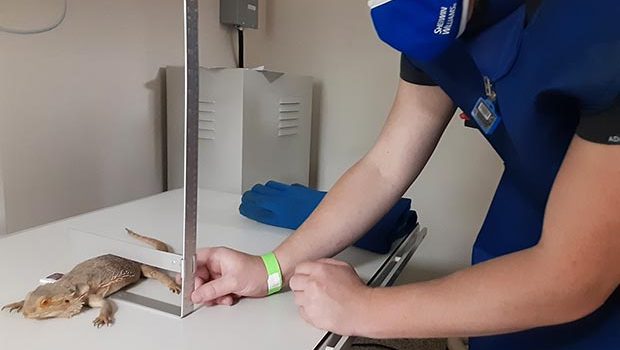






Gloss